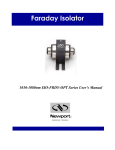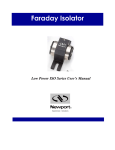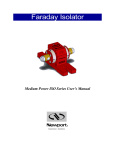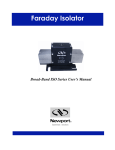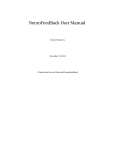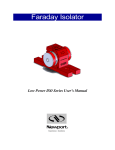Download EOT 1010-1080nm FARADAY ROTATOR/ISOLATOR USER'S
Transcript
EOT 1010-1080nm FARADAY ROTATOR/ISOLATOR USER’S GUIDE Thank you for purchasing your Faraday Rotator or Isolator from EOT. This user’s guide will help answer questions you may have regarding the safe use and optimal operation of your Faraday Rotator or Isolator. TABLE OF CONTENTS I. Faraday Isolator Overview .......................................................................................................... 1 II. Safe use of your EOT Faraday Isolator ...................................................................................... 2 III. The EOT 1010-1080nm Faraday Isolator ................................................................................. 4 IV. Using your Faraday Isolator ..................................................................................................... 7 V. Tuning your Faraday Isolator ..................................................................................................... 8 VI. Diagrams: 1010-1080nm Faraday Rotator/Isolator ................................................................ 10 VII. Warranty Statement and Repair ............................................................................................ 11 VIII. Specifications: 1010-1080nm Faraday Rotators and Isolator .............................................. 12 I. Faraday Isolator Overview Your EOT Faraday Isolator is essentially a unidirectional light valve. It is used to protect a laser source from destabilizing feedback or actual damage from back-reflected light. Figure 1 below identifies the main elements of your Faraday Isolator. Magnet Housing Adjustment Screw Transmission Arrow Serial Number Escape Port Input Polarizer Mount Polarizer Cover Ring Clamp Output Polarizer Mount Baseplate Figure 1: EOT 1010-1080nm Faraday Isolator The Faraday Isolator is a cylindrically-shaped magneto-optic device. Strong Neodymium Iron Boron permanent magnets are used to generate high (>10,000 Gauss) axiallyoriented fields within the magnet housing. The strong longitudinal field causes 45 Electro-Optics Technology, Inc. 5835 Shugart Lane Traverse City, MI 49684 (231)935-4044 ● (800)697-6782 ● Fax: (231)935-4046 ● [email protected] ● www.eotech.com Page 1 of 13 degrees of non-reciprocal polarization rotation for propagating light via the Faraday Effect in the terbium gallium garnet (“TGG”) crystal located within the magnet housing. In operation the magnet housing is sandwiched between input and output polarizers that have their transmission axis oriented 45 degrees relative to each other to account for the 45 degrees of Faraday rotation in the TGG crystal in the forward (transmission) direction. In the reverse (isolation) direction the non-reciprocal Faraday rotation and the 45 degree polarizer transmission axis angle add so that the polarization transmitted by the output polarizer is rejected at the input polarizer. Your EOT Faraday Isolator is labeled with a serial number on the baseplate of the device. II. Safe use of your EOT Faraday Isolator The operational hazards presented to operating personnel by the use of your EOT Faraday Isolator are listed below. An explanation of how the Faraday Isolator is designed together with procedures users can employ to eliminate or minimize these hazards is presented in italics. 1. Danger of sharp ferromagnetic objects being attracted to the residual permanent magnet fields outside of the ISP Rotator. This hazard is of most concern if such fields cause flying objects when being handled. Your EOT Faraday Isolator requires strong internal magnetic fields to operate properly. Efforts have been made to minimize external fields from the device while still maintaining a relatively small and cost-effective package. The external fields are designed to be well within federal safety guidelines which limit external fields from magnetic devices to be less than 2KGauss at a radial distance of 5cm from the outside of the device. However, such fields can be sufficient to attract nearby objects such as knives and razor blades. Should attraction of such objects begin to occur, there would be a strong attractive force directing these objects towards the interior of the magnet housing. This could be particularly likely to result in injury (e.g. a cut or puncture wound) if such attraction occurred while the device was being handled – particularly if a body part of the operating personnel is near a beam aperture (i.e. end) of the device. To minimize the above risks remove all loose ferromagnetic objects from the path over which your EOT Faraday Isolator is to be moved prior to attempting to move it. Do not pick up the isolator by its ends (i.e. apertures) where the attractive magnetic fields are strongest. Always pick the isolator up along its sides. 2. Never attempt to disassemble the magnetic housing of your Faraday Rotator/Isolator. Serious injury could result. 3. Reflection of rejected beams from the input and output polarizer. The polarizer covers have been rotated at the factory to block all beams rejected from the polarizers. In the event that your Faraday Isolator will be used with transmitted average powers in excess of 25W, or will block backward propagating light in excess of 0.5W Electro-Optics Technology, Inc. 5835 Shugart Lane Traverse City, MI 49684 (231)935-4044 ● (800)697-6782 ● Fax: (231)935-4046 ● [email protected] ● www.eotech.com Page 2 of 13 average power, these polarizer covers must be rotated to allow rejected beams to exit through the escape ports (see Figure 1) onto user-supplied beam dumps. These rejected beams can represent a hazard to users and/or their colleagues. Care must be exercised to ensure that all rejected beams (both transmission and isolation directions) are accounted for and terminated into functional beam dumps. Wherever possible keep the strongest rejected beams in the horizontal plane of the table or otherwise safest direction (typically down into the table). Always wear laser safety glasses or goggles consistent with all laser frequencies and power levels present. See Sections III and IV for further details. 4. Failure of operating personnel to observe standard laser safety by sighting down through the ISP Rotator when laser radiation is present. The optical elements within the EOT Faraday Isolators can be transmissive throughout the visible and near infrared. Consequently it is never appropriate to view through the device in either the transmission or isolation direction when laser radiation is present – even with laser safety goggles. Never sight through your EOT Faraday Isolator in either direction when there is any possibility of laser radiation being present. 5. Harm caused by external magnetic fields. Your EOT Faraday Isolator has been designed to meet existing federal safety guidelines for external fields as noted previously. Such guidelines could change in the future as more information becomes known or reviewed regarding the interaction between magnetic fields and human health. Since various claims exist regarding the potential harmful (and beneficial!) effects of magnetic fields on humans it is prudent to limit interaction with these fields as much as possible. Personnel with any magnetically-sensitive implants such as pacemakers should present a copy of this report and consult their medical doctor regarding any potential complications which could arise from the isolator external magnetic fields. 6. Other non-health related hazards. The Faraday Isolator external magnetic fields can draw ferromagnetic objects into the magnet housing which can damage the optical elements within the device. Keep a suitable area from the Faraday Isolator in all directions clear of any loose ferromagnetic objects. Ideally, use non-magnetic tools (such as stainless steel or titanium) and hardware to secure the Faraday Isolator. If only ferromagnetic tools are available use extreme care when using them around the Faraday Isolator. It is always helpful to bring such tools towards an aperture (or end) radially rather than along the optical beam path. Doing this ensures that the fields will tend to pull such objects into the magnet housing endplate rather than into the optical aperture. Where possible use two hands, one to hold the tool and the other to guide it to the desired destination. Electro-Optics Technology, Inc. 5835 Shugart Lane Traverse City, MI 49684 (231)935-4044 ● (800)697-6782 ● Fax: (231)935-4046 ● [email protected] ● www.eotech.com Page 3 of 13 Another concern regarding external magnetic fields is their effect on magneticallysensitive devices. The external fields are strong enough to induce a pulse of current in electronic devices (such as digital watches) that can destroy them. The fields can also disrupt the operation of other mechanical devices with ferromagnetic parts in them. Finally, the external fields can erase information from magnetic strips such as those found on credit and ID cards. Remove all magnetically-sensitive materials and devices such as watches, computer hard drives, and magnetic strips from operators prior to working in the proximity of an isolator. III. The EOT 1010-1080nm Faraday Isolator Polarizer Clamp Ring Input Polarization Axis V, 45, H Polarizer Dust Cover Polarization Transmission Axis Scribe line Figure 2: Overall view of an EOT 1010-1080nm Faraday Isolator With the polarizer covers off, a polarizing beamsplitter cube (“PBSC”) can be seen at each end of the device. The inscribed arrow on the baseplate shows the transmission direction. The output PBSC is seen to be oriented with its transmission axis rotated 45 degrees relative to the input PBSC. The input polarization shown is horizontal. The central magnet housing together with the TGG crystal residing in its center forms a Faraday Rotator. The Faraday Rotator rotates the input horizontal transmission axis by 45 degrees so that transmitted light has a polarization aligned with the output transmission axis. The input and output PBSCs work in conjunction with the central Faraday Rotator to form a Faraday Isolator as described previously in Section I. Figures 3 and 4 below show input views of an EOT 1010-1080nm Faraday Isolator. Figure 3: Horizontal Input Polarization Figure 4: Vertical Input Polarization Electro-Optics Technology, Inc. 5835 Shugart Lane Traverse City, MI 49684 (231)935-4044 ● (800)697-6782 ● Fax: (231)935-4046 ● [email protected] ● www.eotech.com Page 4 of 13 Figure 3 shows a device aligned for a horizontal input polarization. The “dot” superimposed on one of the polarization transmission axis scribe lines on the endplate of the input polarizer mount denotes the side of the input PBSC to which backward propagating (i.e. isolation direction) light will get directed. In the case shown this direction is to the right. Figure 4 shows a device aligned for a vertical input polarization. Since the “dot” is on the bottom side of the polarizer, backward propagating light will get directed downward as shown. Figures 5 and 6 below show output views of an EOT 1010-1080nm Faraday Isolator. In both cases the Faraday Isolators have been adjusted for horizontal input polarization. Figure 5: Negative Z rotation Figure 6: Positive Z rotation Figure 5 shows a Faraday Isolator configured for negative Z rotation. Coarse wavelength tuning adjustment can be made by aligning the polarization transmission scribe lines to the appropriate scribe line on the polarizer clamp ring. When the polarization transmission axis scribe line is aligned with the line labeled “1030” the device is nominally adjusted to operate optimally at 1030nm. If the polarization transmission axis scribe line is aligned with the line labeled “A” then the device is nominally adjusted to operate optimally at 1010nm. If the polarization transmission axis scribe line is aligned with the line labeled “B” then the device is nominally adjusted to operate optimally at 1045nm. Again, the “dot” on the output polarizer mount denotes the side of the output PBSC to which backward propagating (i.e. isolation direction) light will get directed. In the case shown this direction is upward and to the left. Figure 6 shows a Faraday Isolator configured for positive Z rotation. Again, when the polarization transmission axis scribe line is aligned with the line labeled “1030” the device is nominally adjusted to operate optimally at 1030nm. However, if the polarization transmission axis scribe line is aligned with the line labeled “A” then the device is nominally adjusted to operate optimally at 1045nm. Conversely, if the polarization transmission axis scribe line is aligned with the line labeled “B” then the device is nominally adjusted to operate optimally at 1010nm. Again, the “dot” denotes the side of the output PBSC to which backward propagating (i.e. isolation direction) light will get directed. In the case shown this direction is upward and to the right. Electro-Optics Technology, Inc. 5835 Shugart Lane Traverse City, MI 49684 (231)935-4044 ● (800)697-6782 ● Fax: (231)935-4046 ● [email protected] ● www.eotech.com Page 5 of 13 EOT Faraday Isolators are factory aligned as per the model number specified in a purchase order. The information below shows the range for each field in the model number together with the definition of the coordinate axis system which defines the Z rotation sense. Numbering Fields and Coordinate System for EOT 1010-1080nm Faraday Isolator General Format for Numbering Field: AA-B-CCCC-DDD-EEE Field Description: 1. “AA” is the aperture size, e.g. 08=8mm. 2. “B” is the device type. I=isolator; R=rotator. 3. “CCCC” is the operating wavelength in nm. 4. “DDD” is the input polarization axis angle. A right hand X, Y, Z Cartesian coordinate system is used, in which the direction of beam propagation away from the laser source is along the positive Z axis. The X axis is in the plane of the baseplate. The Y axis is vertical, normal to the plane of the baseplate. The XY plane forms the plane of polarization. The XZ plane forms the plane of the baseplate. As an example, a horizontal input polarization is 000 or 0 degrees. A vertical polarization is 090, or 90 degrees. If no polarization is selected by the customer, 000 will be assigned. For rotators, this field does not apply. 5. “EEE” is the output polarization, which is 45 degrees from the input polarization if no waveplate is used. If a waveplate is used and no output polarization is specified, the default setting is the input polarization plus 90 degrees. The angle convention is the same as described for “DDD”. For rotators, this field does not apply. Y-axis=090 Positive Z-rotation +Z-axis = Direction of Beam Propagation (Direction of arrow on device) X-axis=000 Laser Source Electro-Optics Technology, Inc. 5835 Shugart Lane Traverse City, MI 49684 (231)935-4044 ● (800)697-6782 ● Fax: (231)935-4046 ● [email protected] ● www.eotech.com Page 6 of 13 IV. Using your Faraday Isolator Observe the guidelines for safe use of your Faraday Isolator found in Section II above when removing your isolator from its shipping container. Do not remove the protective dust-cover end caps from the polarizers until the device is in a clean, relatively dust-free environment. Figure 7: Remove the protective dust cover end caps in a clean environment Save the protective end caps, packaging material and containers in the event that the device should ever need to be returned to EOT. Verify that the input and output polarization states are consistent with the intended mode of operation as described by the purchase order model number. If not, either send the device back to EOT (see Section VII) or, if desired, readjust the isolator as required (see Section V). With the source laser off, or running at very low power (less than 250mW), position the Faraday Isolator such that the source laser beam can be directed through the input aperture. Critical alignment of the Faraday Isolator should be done at low power (less than 250mW) in order to prevent optical damage to your isolator or laser source. Use IR cards, IR viewers, or heat-sensitive film to ensure that the source laser beam is centered on the input and output apertures. It is also preferable to use an IR viewer to ensure that weak reflections from AR coated optical surfaces in the Faraday Isolator are not being directed back into the source laser. The optical surfaces in the Faraday Isolator are angled slightly to reduce these reflections. However, if any such reflections exist the device may typically be tilted by a small amount to ensure that such back-reflections are not coaxially aligned with the source laser beam. Increasing the distance between the Faraday Isolator and the source laser can also help ensure that no reflections couple back into the source laser if necessary. Electro-Optics Technology, Inc. 5835 Shugart Lane Traverse City, MI 49684 (231)935-4044 ● (800)697-6782 ● Fax: (231)935-4046 ● [email protected] ● www.eotech.com Page 7 of 13 At this point the Faraday Isolator should be secured to the work surface with two (2) ¼ 20 or M6 screws – one for each slot in the baseplate flanges. Steel (ferromagnetic) ball drivers or other such wrenches will be attracted to the external magnetic field surrounding the device. If possible use anti-magnetic stainless steel or titanium tools. If ferromagnetic tools are used it is desirable to introduce them slowly towards the device from the sides along the direction of the baseplate flange slots. If the Faraday Isolator will be used with average powers in excess of 25W transmitted or 0.5W rejected backward propagating radiation the polarizer covers will need to be rotated so that the escape ports allow rejected polarization light to be safely dumped onto a beam dump. Failure to allow these rejected polarizations to escape can cause the device to heat up. Such heat can degrade the performance of the Faraday Isolator, or in severe cases, cause damage to optical components in the isolator. While working with low alignment level power and wearing safety glasses physically grasp the polarizer cover and rotate it by 90 degrees. Any rejected polarized beams (in either the forward or backward propagating directions) can now exit the polarizer cover. Use an IR viewer or IR card to locate these beams. Ensure that they are terminated on beam dumps consistent with the maximum amount of power that may be in such beams. In addition to high rejection (>30dB) of any undesired linear polarization component in transmission, the input and output PBSC may reflect as much as 3% of the desired transmitted polarization. Again, backward propagating rejected beams will exit from the PBSCs from the side which has a “dot” superimposed on the transmission axis scribe line. Forward transmission rejected beams will exit from the other side of the PBSCs. If the Faraday Isolator is used in application where strong reflections and/or optical gain elements (amplifiers) exist there may be very high power rejected beams for backward propagating light at the input polarizer. If the average power levels used do not exceed 25W transmitted or 0.5W of backward propagating power then the polarizer covers may be kept in their factory positioned orientation – all rejected beams will then be blocked by the polarizer cover. However, if the Faraday Isolator is to be used with very high peak intensities it is prudent to allow rejected beams to escape on to external beam dumps to prevent any ablation damage to the nickel-plated polarizer covers. Follow the same procedure above as for high average powers in order to safely terminate all rejected beams. V. Tuning your Faraday Isolator A. Adjusting Input Polarization The transmission axis of the input polarizer is parallel to the scribe line found on the input polarizer endplate. If the linear polarization of the laser source is geometrically known aligning the input polarization of the Faraday Isolator to that of the laser source is straightforward. Simply loosen the #4-40 socket head baseplate clamp screw in the baseplate until the magnet housing rotates freely. Continue to rotate the magnet housing until the input polarizer transmission axis scribe line is aligned to that of your laser source. If the direction of any rejected polarizations at the input polarizer is important they can be determined by noting that the “dot” superimposed on one of the endplate scribe lines is associated with the direction that a backward propagating beam will be directed. Retighten the baseplate clamp screw. Electro-Optics Technology, Inc. 5835 Shugart Lane Traverse City, MI 49684 (231)935-4044 ● (800)697-6782 ● Fax: (231)935-4046 ● [email protected] ● www.eotech.com Page 8 of 13 If it is desired to critically adjust the input polarization for maximum transmission of the Faraday Isolator the power rejected by the input PBSC in transmission can be minimized. This rejected beam can be accessed as per Section IV above. As always, use caution when allowing rejected beams to escape from the polarizer covers. Confirm the direction and safe termination of these beams at low power. Wear laser safety glasses or goggles. Protect your colleagues by safely terminating beams and ensuring that they are wearing safety glasses or goggles as appropriate. At the desired operating power level minimize the power in the rejected input polarization with a power meter or other suitable power indicator. When the power is minimized retighten the baseplate clamp screw. B. Coarse Wavelength Adjustment If it becomes necessary to operate the Faraday Isolator at a wavelength other than the factory aligned wavelength it is possible to optimize the isolation of the devices anywhere within the wavelength range of 1010-1045nm or 1045-1080nm. This can be achieved quickly by simply aligning the polarization scribe line on the output polarizer with the appropriate wavelength indicator scribe line on the polarizer clamp ring. The optimal operating wavelength corresponding to scribe lines labeled “A” and “B” is a function of the rotation sense of the device ordered (see Section III for definition). Use the table below to determine the optimal operating wavelength corresponding to each scribe line. Negative Z Rotation Positive Z Rotation Scribe Line 1010-1045nm 1045-1080nm 1010-1045nm 1045-1080nm “A” 1010nm 1045nm 1045nm 1080nm “1030nm” “1064nm” 1030nm 1064nm 1030nm 1064nm “B” 1045nm 1080nm 1010nm 1045nm To re-align the output polarizer mount, loosen the three button head polarizer clamp ring screws just enough to allow the output polarizer mount to rotate easily. Once adjusted, re-tighten the polarizer clamp ring screws by equal amounts. C. Fine Wavelength Adjustment The above procedure is convenient for a quick realignment of the operating wavelength. To achieve maximum isolation for a given wavelength the following procedure should be used. With the source laser operating at an average power of 0.5W or less (attenuate the beam if necessary to achieve such a low power level) direct the source laser beam through the Faraday Isolator in the reverse direction – through the output polarizer first and then through the input polarizer. Use an IR viewer to view the transmitted radiation to ensure that it is directed onto a power meter. The power meter should be sensitive enough to detect power levels below 0.5µW. If necessary, loosen the baseplate clamp screw to allow the output polarizer transmission axis to be rotated parallel to the source laser polarization axis. Retighten this screw when complete. Electro-Optics Technology, Inc. 5835 Shugart Lane Traverse City, MI 49684 (231)935-4044 ● (800)697-6782 ● Fax: (231)935-4046 ● [email protected] ● www.eotech.com Page 9 of 13 Loosen the three button head output polarizer clamp ring screws just enough so that the output polarizer mount can be rotated (the output polarizer is adjacent to the laser source at this point). Rotate the output polarizer mount until a minimal reading is indicated on the power meter. Retighten the output polarizer clamp ring screws. The minimal reading should be below 0.5µW. If not, call EOT (see Section VII below). The Faraday Isolator is now optimized to operate at the new laser source operating wavelength. It may now be installed for operation in transmission with the laser source as per Section IV. D. Changing the direction of Output Polarizer PBSC Rejected Beam Steering Section A above described how to orient the input polarizer to steer rejected beams as desired. If the output polarizer rejected beam steering direction needs to be changed, loosen the three output polarizer clamp screws and rotate the output polarizer mount by 180° before re-tightening the screws. Depending upon the isolation requirements, follow either Procedure B (coarse adjustment) or Procedure C (fine adjustment) in order to fully optimize the isolation of the device with this output polarizer orientation. E. Waveplate Option and Adjustment As described in Section III above in the Numbering Fields and Coordinate System section, it is possible to order a Faraday Isolator with a half-wave plate on the output. Should any of the above adjustments become necessary, or if the desired output polarization changes, the waveplate will need to be adjusted. To realign the waveplate loosen the radially-oriented setscrew in the output polarizer endplate and rotate the waveplate until the desired output polarization is achieved. Retighten the waveplate set screw. Do not over-tighten. VI. Diagrams: 1010-1080nm Faraday Rotator/Isolator A. 1010-1080nm Faraday Rotator Aperture (mm) A B C D E F G H 2 1.50 1.50 3.00 0.75 2.24 0.75 0.31 1.25 4 8 12 15 20 25 35 45 1.75 2.25 Ø=3.00 Ø=3.75 Ø=3.75 n/a n/a n/a 1.75 2.25 3.66 3.54 3.54 5.25 5.38 5.25 3.63 0.88 2.15 1.00 0.31 1.50 4.00 1.13 2.55 1.00 0.50 2.00 4.00 1.86 2.32 3.00 0.625 2.50 5.00 1.67 4.39 1.50 1.00 3.00 5.00 1.67 4.39 1.50 1.00 3.00 6.50 3.00 7.16 n/a 2.50 4.50 6.50 3.00 8.16 n/a 2.50 4.50 5.00 2.75 7.86 n/a 2.75 5.00 Electro-Optics Technology, Inc. 5835 Shugart Lane Traverse City, MI 49684 (231)935-4044 ● (800)697-6782 ● Fax: (231)935-4046 ● [email protected] ● www.eotech.com Page 10 of 13 B. 1010-1080nm Faraday Isolator Aperture (mm) A B C D E F G H 2 4 8 12 15 20 25 35 45 1.50 1.75 2.25 Ø=3.00 Ø=3.75 Ø=3.75 n/a n/a n/a 1.50 1.75 2.25 3.06 3.54 3.54 5.25 5.25 5.25 3.00 3.63 4.00 4.00 5.00 5.00 6.50 6.50 5.00 0.75 0.88 1.13 1.56 1.67 1.67 3.00 3.00 2.75 3.18 3.01 3.86 4.07 7.03 7.03 10.41 10.80 18.75 0.75 1.00 1.00 3.00 1.50 1.50 n/a n/a n/a 0.63 0.81 1.00 1.12 1.88 1.88 2.00 2.50 2.50 1.25 1.50 2.00 2.50 3.00 3.00 4.50 4.50 5.00 VII. Warranty Statement and Repair EOT warrants its products to be free from defects in material and workmanship and complies with all specifications. EOT will at its option, repair or replace any product or component found to be defective during the warranty period. This warranty applies only to the original purchaser and is not transferrable for a period of one year after date of original shipment. The foregoing warranties shall not apply, and EOT reserves the right to refuse warranty service, should malfunction or failure result from: a. Damage caused by improper installation, handling or use. b. Unauthorized product modification or repair. c. Operation outside the environmental or damage specifications of the product. d. Contamination not reported to EOT within 30 days of the original ship date. This warranty is exclusive in lieu of all other warranties whether written, oral, or implied. EOT specifically disclaims the implied warranties of merchantability and fitness for a particular purpose. In no event shall EOT be liable for an indirect, incidental, or consequential damages in connection with its products. If the customer believes there is a problem with the rotator/isolator, they should immediately contact EOT’s Sales/Customer department at 231-935-4044 or [email protected]. EOT’s Customer Service department will either issue an RMA for the device, or provide the customer with a procedure and authorize the customer to modify the device. All returns should reference the RMA number on the outside of the shipping container and should be sent to: Electro-Optics Technology, Inc. 5835 Shugart Lane Traverse City, MI 49684 (231)935-4044 ● (800)697-6782 ● Fax: (231)935-4046 ● [email protected] ● www.eotech.com Page 11 of 13 Electro-Optics Technology, Inc. Attn: Sales/Customer Service 5835 Shugart Lane Traverse City, MI 46984 USA EOT reserves the right to inspect rotators/isolators returned under warranty to assess if the problem was caused by a manufacturer defect. If EOT determines the problem is not due to a manufacturer defect (an example would be damage to an optical element caused by impact from a loose ball driver or exceeding the damage threshold of the device), repairs will be done at the customer’s expense. EOT will always provide a written quote for repair prior to performing repairs at the customer’s expense. Never attempt to disassemble the magnetic housing of your Faraday Rotator/Isolator. Injury could result. Any indications that an attempt to disassemble the magnetic housing was made will render the warranty null and void. VIII. Specifications: 1010-1080nm Faraday Rotators and Isolator 1010-1045nm Rotator >98% N/A Transmission at 22°C Isolation at 22°C Rotation at Specified Wavelength 45°±2° Pulsed Damage 10J/cm2 at 10ns Thresholda 1J/cm2 at 8ps 1010-1045nm Isolator >92% >30dB 1045-1080nm Isolator >92% >30dB 45°±2° 10J/cm2 at 10ns 1J/cm2 at 8ps 45°±2° 10J/cm2 at 10ns 1J/cm2 at 8ps 45°±2° 10J/cm2 at 10ns 1J/cm2 at 8ps CW damage threshold is 1MW/cm2 Typical Isolator Performance Typical Isolator Performance 100.0 40.0 90.0 35.0 34 96.5 30.0 60.0 25.0 50.0 20.0 40.0 15.0 30.0 10.0 20.0 Isolation (dB) 70.0 Transmission (%) 80.0 Transmission (%) 35 97 33 32 96 31 30 95.5 29 95 28 27 94.5 5.0 10.0 0.0 0.0 0 10 20 30 40 Temperature ( C) Transmission (%) Isolation (dB) 50 26 94 25 1 1.02 1.04 1.06 1.08 Wavelength (µm) Transmission (%) Isolation (dB) Notes: 1. Operating Temperature: Performance of EOT’s Faraday Rotators/Isolators is related to operating temperature. For information on the effect of operating temperature on EOT’s Electro-Optics Technology, Inc. 5835 Shugart Lane Traverse City, MI 49684 (231)935-4044 ● (800)697-6782 ● Fax: (231)935-4046 ● [email protected] ● www.eotech.com Page 12 of 13 Isolation (dB) a 1045-1080nm Rotator >98% N/A Faraday Rotators/Isolators, please review our technical bulletin, Effects of Temperature on EOT’s Faraday Rotators/Isolators. 2. For incident powers ≥50W, please consult EOT: You may either contact EOT’s sales department at [email protected] or view our Custom Rotators page on our website, www.eotech.com. 3. For apertures >20mm: You may either contact EOT’s sales department at [email protected] or view our Large Aperture Rotators/Isolators page on our website. 4. Pulsed Damage Threshold: The pulsed damage threshold of your free space Faraday Rotator or Isolator can be determined at pulsewidths other than 10ns by using the “Root T” scaling method. Please visit our Calculators page on our website. Electro-Optics Technology, Inc. 5835 Shugart Lane Traverse City, MI 49684 (231)935-4044 ● (800)697-6782 ● Fax: (231)935-4046 ● [email protected] ● www.eotech.com Page 13 of 13













